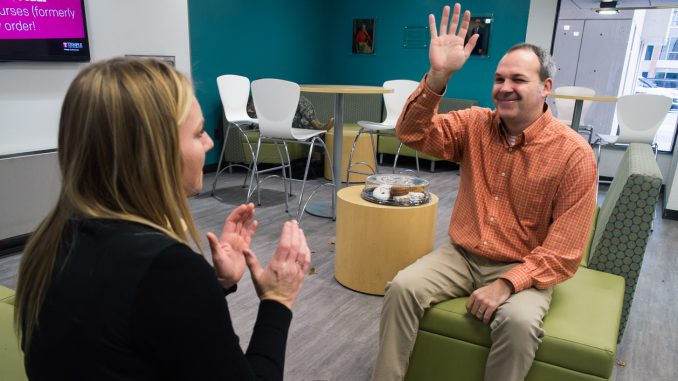
All three American Sign Language instructors at Temple University are deaf. But that does not mean they are limited in their modes of communication.
In the classroom and in their daily lives, Jonathan Hartmann, Melanie Drolsbaugh and Dana Zeuggin communicate through ASL, body language, lip reading, drawing, writing and assistive technology devices.
People who are deaf or hard of hearing are labeled “disabled” under the Americans with Disabilities Act to receive accommodations, like ASL interpreters and protections against disability-based discrimination.
“Culturally, we’re not disabled,” said Hartmann, the director of Temple’s ASL certificate program. “But from a medical perspective…we have to have that label, ‘disabled,’ even though we don’t want it.”
“People who don’t know sign language, they’re disabled,” said Drolsbaugh, a professor in the ASL certificate program in the College of Public Health.
Drolsbaugh described the deaf and hard of hearing community as a second culture or world. Rather than trying to assimilate into hearing culture, the professors said many deaf people are proud of their separate cultural identity.

A 2007 article in The Chronicle Review found that in the past 30 years, deaf scholars and activists view deafness as people belonging to a “linguistic minority,” instead of people who are “hearing-impaired.”
“We don’t like the term ‘hearing-impaired’ because that focuses on what the lack is,” Zeuggin, an ASL instructor, added. “There’s a lot of pride in using ‘deaf’ or ‘hard of hearing.’”
Janessa Carter is a part-time Africology and African American Studies major who is deaf. She also works as a full-time behavioral support aid for preschoolers at the Pennsylvania School for the deaf in Penn-Knox. To communicate with people who do not use ASL, Carter uses interpreters, emails, texting and other forms of communication.
“I read lips, I can speak for myself. …I haven’t really had any problems,” Carter said. “Sometimes, I do wish I had more of that contact.”
Carter falls in the minority of deaf individuals who are also born to deaf parents. Both her mother and father are deaf, which she said prepared her for the challenges she would later overcome in life.
More than 90 percent of deaf children are born to hearing parents, according to the National Institute on Deafness and other Communication Disorders.
If these children are not sufficiently taught ASL or receive cochlear implants, the professors said they may identify with the hearing community. Cochlear implants are electronic devices that provide sound signals to the brain, according to the NIDCD.
Zueggin said there used to be a lot of controversy surrounding cochlear implants, but they are more accepted now. The controversy comes from the idea that using a cochlear implant prohibits people from being fully immersed in either the deaf or hearing world.
None of the professors use cochlear implants. They added that deaf people may choose not to wear the devices if they find them ineffective or are content without hearing.
Emily Brown, a junior psychology major pursuing an ASL certificate, wrote a research paper on cochlear implants.
“You think, if you’re hearing, ‘Why wouldn’t you want to hear?’” Brown said.
She added that she sees things differently now.
Learning ASL helps Brown interact with the deaf community. She had a lively interaction with a deaf family at the Philadelphia Eagles’ Super Bowl parade in February. The family was using ASL to mock Brown and her friends, signing that they thought the group was drunk. Brown said jumped right in, joking and signing that she was sober.
“It’s easy to be more inclusive,” she added.
A deaf culture has yet to come to Temple, Drolsbaugh said, but a small community is growing. Students can get involved in clubs like Talking Hands, a student organization that silent dinners to practice ASL and discuss deaf culture.
Drolsbaugh said that some CODAs — or Children of Deaf Adults — belong to Temple’s deaf community. These are students who can hear, but ASL is their first language and deafness is their first culture.
Carter said that a common mistake hearing people make when interacting with someone who is deaf is talking loudly. She added that the louder someone speaks will not make it easier for her to hear them.
She reiterated that deaf people are not different than those who can hear.
“Deaf people, we’re just like hearing people,” Carter said. “We work hard, we have dreams, we work hard to make our dreams come true just like hearing people.”
“We have a little more challenges in our lives, but we get through it,” she added.


One of the best man is usually the grooms most trustworthy and faithful
friend or relative. One of the best man is normally the grooms most reliable and faithful buddy or relative.
The ushers would be the grooms brothers, cousin, or best pals, or brothers and shut
relatives of the bride. Responsibilities of the best Man Before the wedding, he – pays for his own attire, purchased or rented.
May give the envelope to the officiant before the ceremony.
Throughout the ceremony, he – is just not a part of the processional but
enters with the groom, standing behind the groom and barely to the left.
After the ceremony, he – immediately serves as one of the
witnesses in signing the wedding license. On the reception, he – does not stand in the receiving line
until he can be the father of the groom. After the reception, he – promptly returns each his and the grooms rented formal wear to
the appropriate location.